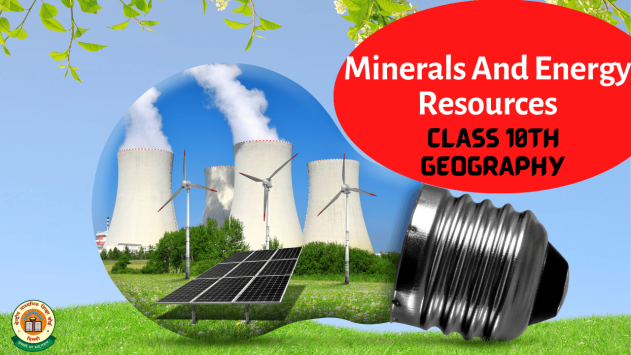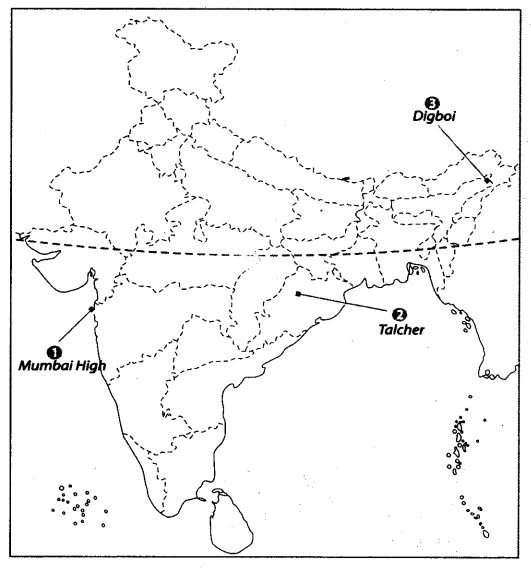Here we have penned down Minerals And Energy Resources Class 10th notes to help the students to be thorough with the lesson Minerals And Energy Resources Class 10th along with the mind map to be able to glance at the lesson at once.
We have also provided you all with the NCERT Solutions For Class 10th Social Science Minerals And Energy Resources along with the map work and important diagrams to help the board-appearing candidates with the lesson and boost their class 10th preparation.
We have also penned down Minerals And Energy Resources Class 10th MCQs to help the students to get a thorough idea of the lesson and help to know the gist of the lesson.
Minerals And Energy Resources Class 10th Notes
Minerals- Minerals are An indispensable part of our lives. Almost everything we use
are made from minerals.
A homogeneous, naturally occurring substance with a definable internal
the structure is called mineral.
Importance of minerals for us:-
Almost everything we use in our daily life, from tiny pin to big ship is made from minerals. Towering buildings, machinery, utensils, means of transport, railway line, and bridges too are made from minerals. Even the food that we eat contains minerals.
Ore:-
Minerals are usually found in ores. An ore is a naturally occurring material having one or more minerals in sufficient concentration mixed with other elements.
Mode of Occurrence of Minerals:-
Minerals generally occur in these forms:-
Through Igneous and Metamorphic rocks:- In igneous and metamorphic rocks minerals may occur in the cracks, crevices, faults, and joints. The smaller occurrences are called veins and the larger are called lodes. In most cases, they are formed when minerals in liquid/molten and gaseous forms are forced upward through cavities towards the earth’s
surface.
They cool and solidify as they rise. Major metallic minerals like tin, copper, zinc, lead, etc. are obtained from veins and lodes.
Through the layers of Sedimentary rocks:– In sedimentary rocks, a number of minerals occur in beds or layers. They have been formed as a result of deposition, accumulation, and concentration in horizontal strata.
Decomposition of surface rocks:-
When the decomposition of surface rocks and the removal of soluble constituents takes place, it leaves a residual mass of weathered material containing mineral ores. Bauxite is formed by the decomposition of surface rocks.
Alluvial deposits or Placer deposits :-
Some minerals are found in the sands of valley floors and at the base of hills. These are known as placer deposits. They are not corroded by water, Example:- gold, silver, platinum, and tin.
Ocean Waters:-
These contain many minerals. Common salt, magnesium, and bromine
are derived from ocean waters, whereas manganese nodules occur in
ocean beds.
Minerals And Energy Resources Class 10th; Mining
The extraction of useful and commercially viable minerals by digging down the earth is called mining.
Basis of classification of minerals:-
This classification is based on their color, shine, hardness, density, and crystallization.
Classification of Minerals:-
Minerals are mainly classified as metallic, non-metallic, and energy minerals.
Metallic Minerals:-
Minerals containing metals are called metallic minerals, like gold,
silver, tungsten, etc.
They are of three types:-
Ferrous:- (In which part of iron is present) Examples:- Iron,
manganese, Nickel, Cobalt, etc.
Non- Ferrous:- (In which part of iron is not present) Examples:-
Copper, Lead, Tin, Aluminium, etc.
Precious Minerals:- Examples:- Gold, Silver, Platinum, etc.
Ferrous Minerals:-
These account for about three-fourths of the total value of the production of metallic minerals. They provide a strong base for the development of metallurgical industries. Iron-ore and Manganese are the best examples of ferrous minerals.
Iron Ore:-
It is the basic mineral and the backbone of industrial development. India has abundant resources of good quality iron ore.
Magnetite:-
The finest iron ore is magnetite. It has a very high iron content up to 70%. Magnetite has excellent magnetic qualities, especially valuable in the electrical industry.
Haematite:-
Haematite ore has an iron content of up to 50-60%. It is the most important industrial iron ore in terms of the quantity used.
Minerals And Energy Resources Class 10th: Major iron ore belts in India
There are four major iron ore belts in India:-
Orissa – Jharkhand belt
Maharashtra – Goa belt
Bellary-Chitradurga-Chikmaglur-Tumkur belt
Durg-Bastar-Chandrapur belt
Manganese:-
It is a metallic element used in the manufacturing of steel and ferromanganese
alloys. Nearly 10 kg of manganese is used to manufacture one tonne of steel.
It is also used in manufacturing insecticides, bleaching powder, and paints. Orissa has the largest share of manganese production in India.
Non-Ferrous Minerals:-
Minerals that do not contain iron content are called non-ferrous minerals. The reserves and production of non-ferrous minerals in India are not sufficient. These minerals include copper, lead, zinc, bauxite, gold, etc which are vital for various industries like metallurgical, engineering and electrical industries.
Copper:-
Haematite ore has an iron content of up to 50-60%. It is the most important industrial iron ore in terms of the quantity used. It is an important mineral due to its excellent electrical conductivity. It is used in the manufacturing of electrical cables and in electronics and
chemical industries.
The leading producers of copper in India are:-
Khetri mines in Rajasthan,
Balaghat mines in Madhya Pradesh
Singhbhum district of Jharkhand.
Bauxite:-
Bauxite ore is used for obtaining aluminum. It is formed by the decomposition of a wide variety of rocks rich in aluminum silicates. Bauxite is a clay-like substance from which alumina is extracted and later alumina developed into aluminum.
Amarkantak plateau, Maikal hills, and the plateau region of Bilaspur-Katni are the main regions of bauxite deposits in Madhya Pradesh. Odisha is the largest bauxite-producing state in India with 49% of the country’s total production in 2016-17. Panchpatmali deposits in the Koraput district are the most important centers of bauxite deposits in Odisha.
Aluminum:-
Aluminum is known for its strength and lightness. It is widely used in
manufacturing of utensils, electrical goods, etc.
Non-Metallic Minerals:-
The basic characteristic of non-metallic minerals is that they do not
yield new products on melting. Mica is an important non-metallic mineral.
Mica:-
It is used in electrical and electronics industries due to its di-electric strength, low power loss factor, insulating properties, and resistance to high voltage. Mica occurs in the form of plates or leaves, which can be split into thin sheets. Mica can be clear, black, green, red, yellow, or brown.
Its deposits are mainly found on the Northern edge of the Chota Nagpur plateau. Koderma-Gaya-Hazaribagh belt of Jharkhand is the leading producer of mica. Other mica-producing regions are Ajmer (Rajasthan) and Nellore (Andhra
Pradesh).
Limestone:-
Limestone is a rock mineral found in sedimentary rocks. It is composed of
calcium carbonates or calcium and magnesium carbonates. Limestone is used for smelting iron ore in blast furnaces of steel plants and is the basic raw material for manufacturing cement. Rajasthan has the largest share in limestone production in India i.e. 21%, in 2016-17.
Hazards of Mining:-
Why does the mining industry is called a killer industry?
Mining is a hazardous industry. It is known as a killer industry due to the following reasons:- This industry affects the health of the miners and the environment.
They have to breathe in dust and noxious fumes. Miners inhale this regularly which makes them vulnerable to pulmonary diseases. The risk of collapsing mine roofs, inundation, and fires in the coal mine is a constant threat to miners.
The water sources in the region get contaminated due to mining. Dumping of waste and slurry leads to degradation of land, and soil, and increases in stream and river pollution.
Conservation of Minerals:-
Need to conserve the minerals:-
- Minerals are the base of our agriculture and Industries.
- Are finite and non-renewable.
- The stock is very limited.
- The total deposit is an insignificant fraction i.e. one percent of the earth’s
crust. - Takes millions of years to be created and concentrated.
- We are rapidly consuming mineral resources.
Methods of conservation of Resources:-
1. Low wastage during mining and excavation. As far as possible use wood or plastic (Certified).
2. Reuse junk waste and old things.
3. Recycle metals, use scrap metals, and search for other substitutes.
4. Use in a planned and sustainable manner.
Minerals And Energy Resources Class 10th: Energy Resources
Resources that are used as power to run industries are called energy resources. Fuel minerals like coal, petroleum, natural gas, uranium, and electricity can generate energy.
Energy resources can be classified as:-
1. Conventional or non-conventional sources.
2. Non-conventional sources of energy
Conventional Sources of Energy:-
Conventional Sources like firewood, cattle dung cake, coal and
petroleum, natural gas, and electricity (both hydel and thermal) have been
used for a long time.
Non-Conventional Sources of Energy:-
Non-conventional sources of energy have come into use recently. These include wind power, solar energy, tidal energy, geothermal energy, atomic energy, and biogas energy. They are freely available, usually inexhaustible, and renewable.
Conventional Sources of Energy
Coal:-
It is the most abundantly available fossil fuel in India. It fulfills a greater amount of energy needs of the country. It is because India is highly dependent on coal for meeting its commercial energy needs. Coal is a bulky material (of large size for its weight), which loses weight on use as it is reduced to ash. Thus, heavy industries and thermal power
stations are located on or near the coalfields.
Uses of Coal:-
Coal is used for power generation, to supply energy to industry, and for
domestic needs
Formation of Coal:-
Coal is formed by the compression of plant materials over millions of years. The degree of compression formed due to pressure of upper layers of the Earth and the depth at which compression takes place results in the formation of different types of coal.
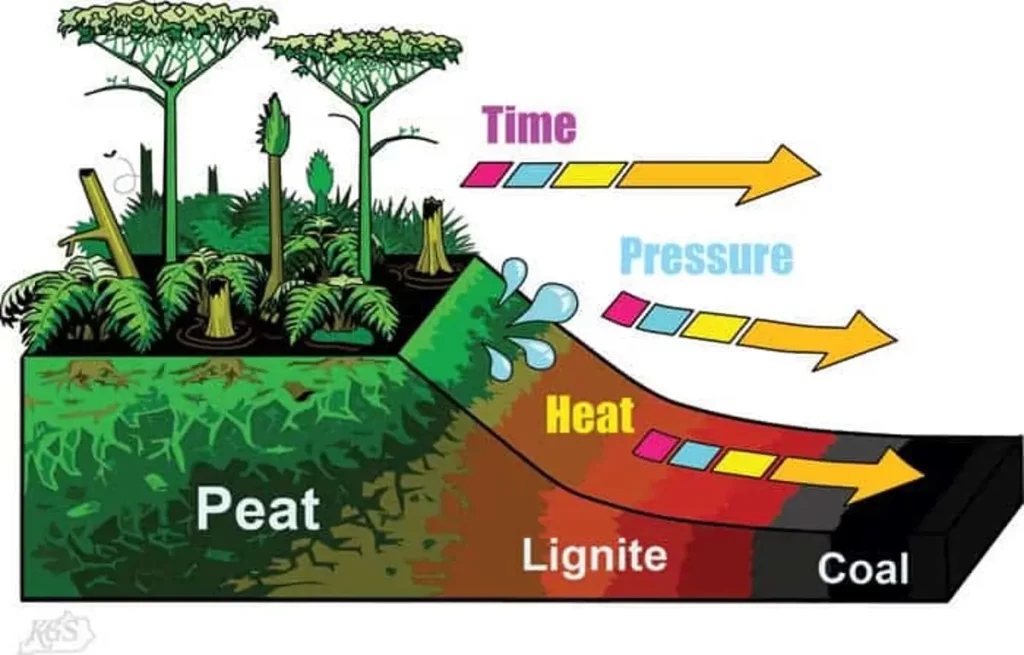
Types of Coal:-
Depending on the degrees of compression, the depth, and the time of burial
during its formation, there are the following varieties of coal
1. Peat:– It is formed by the decaying of plants in swamps. It has a low carbon
content and low heating capacity and high moisture content.
2. Lignite:- It is low-grade brown coal. It is soft and has high moisture content. It
is used for electricity generation. The important lignite reserves are in
Neyveli in Tamil Nadu.
3. Bituminous:- It is the most popular coal in commercial use. High-grade bituminous coal is ideal for use in metallurgy. It has special value for smelting iron in blast furnaces. It is found in greater depths.
4. Anthracite:- This is the highest quality hard coal.
Occurrence of Coal in India:-
In India, coal occurs in rock series of the following two main geological
ages:-
Gondwana Coal:-
This coal was formed over 200 million years ago. This type of coal is used in
metallurgy. The major sources of Gondwana coal are located in the Damodar valley
(West Bengal-Jharkhand). In this belt, Jharia, Raniganj, and Bokaro are important coal fields. Coal deposits are also present in the Godavari, Mahanadi, Son, and Wardha valleys.
Tertiary Coal:-
This coal was formed 55 million years ago. This type of coal is found in the
North-Eastern states of Meghalaya, Assam, Arunachal Pradesh and
Nagaland.
Petroleum:-
It is also known as mineral oil and ‘liquid golď’. It is the second highest energy source (after refining into various products like furnace oil, diesel, petrol, kerosene, etc) used in India after coal.
It is used as fuel. Petroleum refineries provide raw materials for synthetic textile, fertilizer, chemical industries, lubricants, and fuel which is called the ‘Nodal Industry’. About 63 percent of India’s petroleum production is from Mumbai High, 18 percent from Gujarat, and 16 percent from Assam.
Natural Gas:-
It is a clean energy resource as it gives out very little carbon and pollutants on burning. It is found with or without petroleum. As compared to coal and petroleum products, it burns with very low emissions of harmful gases and other pollutants.
Uses of Natural Gas:-
It is used as a source of energy as well as an industrialist material in the petrochemical industry. Natural gas is mainly used by the fertilizer and power industries. The use of Compressed Natural Gas (CNG) for vehicles to replace liquid fuel is also increasing.
Reserves of Natural Gas In India:-
The offshore region of the Krishna-Godavari basin has the largest
amount of natural gas currently available in India.
It is also available along the West coast in Mumbai high, Gulf of Cambay
and in Andaman and Nicobar islands.
Electricity:-
It has a wide range of applications in today’s world. The per capita
consumption of electricity in a place is considered as an index of
development.
There are two ways through which electricity is generated.
These are:-
Thermal electricity:- Thermal electricity is generated by burning fossil
fuels, (coal, petroleum, natural gas, etc) that supplies energy to drive
turbines. The thermal power stations use non-renewable resources i.e.
fossil fuels for generating electricity.
Hydroelectricity:- Hydroelectricity is generated by flowing water.
This energy is pollution free and commonly used all over India for
constructing multi-purpose projects, like Bhakra Nangal, Damodar valley,
the Kopili Hydel Project, etc.
Minerals And Energy Resources Class 10th: Non-Conventional Sources of Energy
Nuclear or Atomic Energy
It is generated by altering the structure of atoms that releases heat and energy which is used to generate electric power. Uranium and thorium are found in the Aravalli ranges of Rajasthan and Jharkhand and monazite sands of Kerala which are used for generating
nuclear or atomic energy.
Solar Energy
India is a tropical country. It has enormous possibilities for tapping solar energy. It is used for a variety of purposes like electric power generation (using photovoltaic panels) and for heating purposes. It is fast emerging as a fuel source in rural and remote places, thereby
reducing their dependence on firewood and dung cakes.
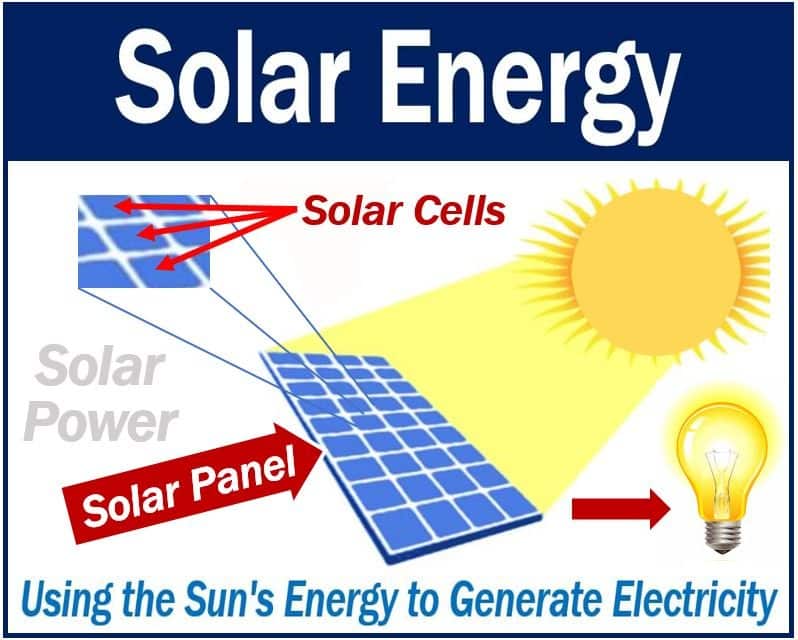
Wind Power
India has great potential for wind power. The largest wind form cluster is located in Tamil Nadu from Nagar coil to Madurai. Apart from these, Andhra Pradesh, Karnataka, Gujarat, Kerala, Maharashtra, and Lakshadweep have important wind farms. Nagarcoil and Jaisalmer (Rajasthan) are very famous for the effective use of wind energy in India.
Biogas
It is generated by the decomposition of organic matter like shrubs, farm waste, and animal and human wastes in biogas plants. It has higher thermal efficiency than Kerosene, dung cake, and charcoal. It is cheap, environmentally friendly, and prevents the loss of trees used for firewood. It is used as fuel for cooking and lighting in rural areas. It also provides improved quality of manure.
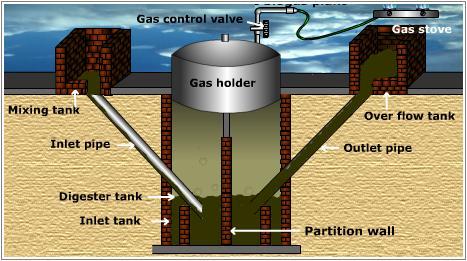
Biogas plants are set up by municipalities, cooperatives, and also by individuals. Biogas plants are also known as ‘Gobar gas plants’ in rural India.
Tidal Energy
It is the energy generated by the movement of oceanic tides, which can be
harnessed to generate electricity.
Process of generation of tidal energy
To produce electricity, flood gate dams are built across inlets from where water enters during high tide. The gates are closed, once enough water flows in after the tide falls outside the flood gate.
The water retained inside the gate is made to flow out through a pipe that carries it through a power-generating turbine.
Ideal conditions places for generating tidal energy in India
In India, the Gulf of Khambhat, the Gulf of Kutch in Gujarat on the Western coast, and the Gangetic delta in the Sunderban regions of West Bengal provide ideal conditions for utilizing tidal energy.
Geothermal Energy
It refers to the heat and electricity produced by using the heat from the
interior of the Earth.
Geothermal energy exists because the Earth grows hotter with an increase in depth. In some places, this geothermal gradient is so high that high temperatures are found at a shallow depth.
Groundwater present in these areas absorbs heat from the rocks and becomes hot and rises as steam. This steam is used to drive turbines for the generation of electricity.
Parvati valley near Manikarn in Himachal Pradesh and Puga valley in Ladakh is two experimental projects to produce geothermal energy.
Conservation of Energy Resources
Since energy is a basic requirement for economic development, we need to conserve it. To have sustainable development, we need to promote energy conservation by avoiding wastage and increasing the use of renewable energy sources. So, we should conserve energy resources by using public transport systems instead of individual vehicles. switching off electrical appliances when not in use using power-saving devices using non-conventional sources of energy.
Minerals And Energy Resources Class 10th: Mind Map
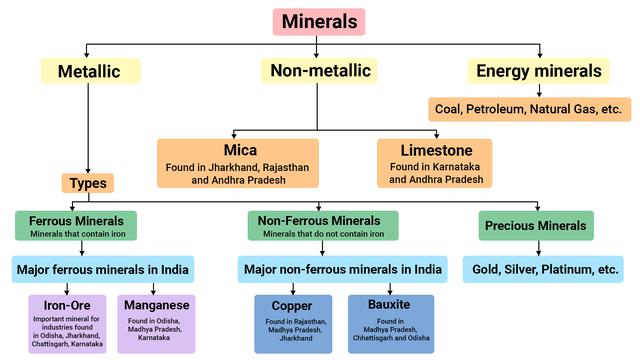
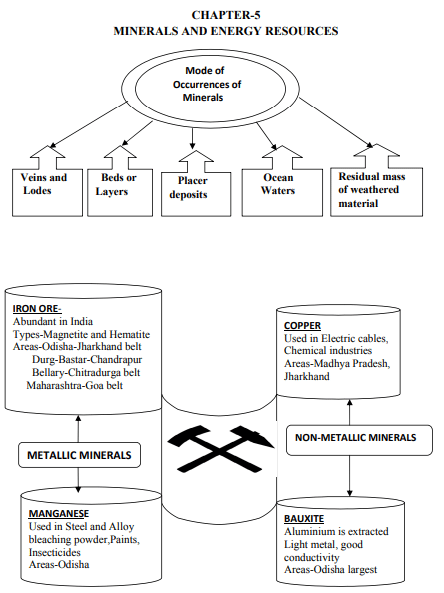
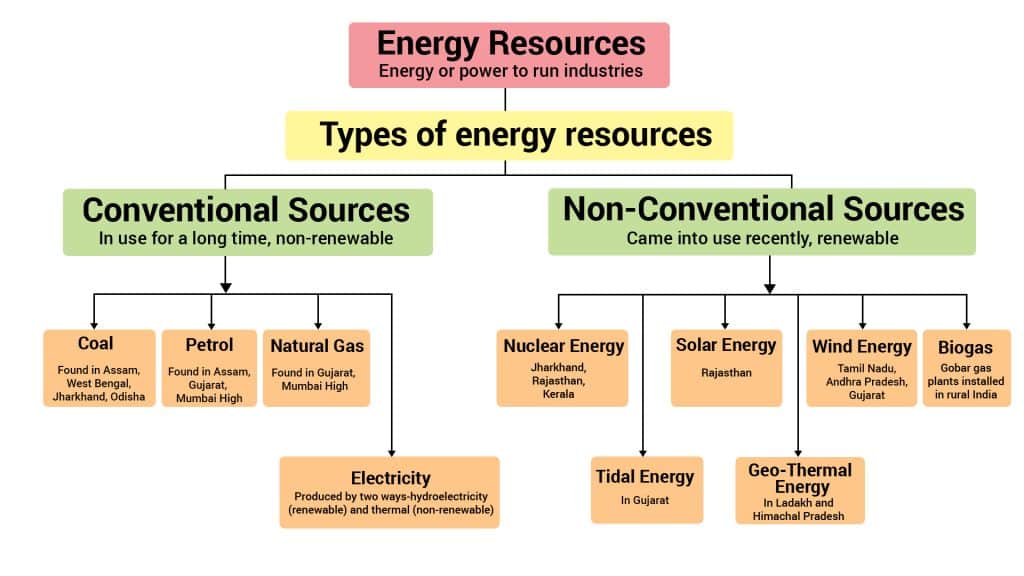
Minerals And Energy Resources Class 10th: MCQs
Question 1.
The mineral used in the manufacture of steel is:
(a) Copper
(b) Lead
(c) Magnesium
(d) Manganese
Answer
Answer: (d) Manganese
Manganese is used in the manufacturing of steel.
Question 2.
The state which is the largest producer of manganese is:
(a) Gujarat
(b) West Bengal
(c) Bihar
(d) Orissa
Answer
Answer: (d) Orissa
Orissa is the largest producer of manganese.
Question 3.
The ……………………. mines of Madhya Pradesh produce 52 percent of India’s copper.
(a) Kolaghat
(b) Khetri
(c) Balaghat
(d) Singbhum
Answer
Answer: (c) Balaghat
The Balaghat mines in Madhya Pradesh produce 52 percent of India’s copper.
Question 4.
The most important bauxite deposits in the state of Orissa are in the……………………… district.
(a) Singbhum
(b) Khetri
(c) Balaghat
(d) Koraput
Answer
Answer: (d) Koraput
The most important bauxite deposits in the state of Orissa are in the Koraput district.
Question 5.
The mineral is made up of a series of plates or leaves in:
(a) Bauxite
(b) Lead
(c) Copper
(d) Mica
Answer
Answer: (d) Mica
The mineral made up of a series of plates or leaves is mica.
Question 6.
Nellore mica belt is in the state of:
(a) Orrisa
(b) Bihar
(c) Madhya Pradesh
(d) Andhra Pradesh
Answer
Answer: (d) Andhra Pradesh
Nellore mica belt is in the state of Andhra Pradesh.
Question 7.
The basic raw material for the cement industry and essential for smelting iron ore in the blast furnace is:
(a) Iron
(b) Mica
(c) Limestone
(d) Sodium chloride
Answer
Answer: (c) Limestone
Limestone is the basic raw material for the cement industry and essential for smelting iron ore in the blast furnace.
Question 8.
Low-grade brown coal is known as:
(а) Bituminous
(b) Anthracite
(c) Lignite
(d) None of the above
Answer
Answer: (c) Lignite
Low-grade brown coal is known as lignite.
Question 9.
The highest quality hard coal is:
(a) Bituminous
(b) Anthracite
(c) Lignite
(d) None of the above
Answer
Answer: (b) Anthracite
Anthracite is the hardest quality of hard coal.
Question 10.
Tertiary coals occur in which of the following:
(a) Orissa, West Bengal, and Bihar
(b) Punjab, Haryana, Jammu, and Kashmir
(c) Meghalaya, Assam, Arunachal Pradesh, and Nagaland
(d) Gujarat, Kerala, Tamil Nadu, and Karnataka
Answer
Answer: (c) Meghalaya, Assam, Arunachal Pradesh, and Nagaland
Tertiary coals occur in the states of Meghalaya, Assam, Arunachal Pradesh, and Nagaland.
Question 11.
About ………………… percent of India’s petroleum production is from Mumbai High.
(a) 63
(b) 73
(c) 83
(d) 93
Answer
Answer: (a) 63
About 63 percent of India’s petroleum production is from “Mumbai High.
Question 12.
Large reserves of natural gas have been discovered in the:
(a) Ganga – Godavari Basin
(b) Ganga – Yamuna Basi
(c) Ganga – Brahmaputra Basin
(d) Krishna – Godavari Basin
Answer
Answer: (d) Krishna – Godavari Basin
Large reserves of Natural gas have been discovered in the Krishna-Godavari Basin.
Question 13.
The number of thermal power plants in India is:
(a) 110
(b) 210
(c) 310
(d) 410
Answer
Answer: (c) 310
The number of Thermal Power Plants in India is 310.
Question 14.
Nuclear energy is obtained by altering the:
(a) Structure of atoms
(b) Structure of electrons
(c) Structure of protons
(d) None of the above
Answer: (a) Structure of atoms
Nuclear energy is obtained by altering the structure of atoms.
Question 15.
The largest solar plant in India is located at:
(a) Madhapur
(b) Khetri
(c) Kolhapur
(d) Jaisalmer
Answer
Answer: (a) Madhapur
The largest solar plant in India is located at Madhapur.
Question 16.
The largest wind farm cluster is located in Tamil Nadu from:
(a) Nagarcoil to Madurai
(b) Nagarcoil to Bhuj
(c) Madhurai to Khetri
(d) none of the above
Answer
Answer: (a) Nagarcoil to Madurai
The largest wind farm cluster is located in Tamil Nadu from Nagarcoil to Madurai.
Question 17.
In rural areas biogas for domestic consumption is produced from:
(a) S metals, plastics, etc.
(b) Animal and human waste and plastics
(c) Shrubs, farm waste, animal and human waste
(d) None of the above
Answer
Answer: (c) Shrubs, farm waste, animal and human waste
The materials used to produce biogas for domestic consumption in rural areas are shrubs, farm waste, and animal and human waste.
Question 18.
Oceanic tides are used to generate:
(a) Electricity
(b) Steam
(c) Power
(d) None of the above
Answer
Answer: (a) Electricity
Oceanic tides are used to generate electricity.
Question 19.
Where are the projects to harness geothermal energy, located in India:
(a) Parvati valley and Puga valley
(b) Saraswati valley and Puga valley
(c) Ganga valley and Puga valley
(d) Yamuna valley and Puga valley
Answer
Answer: (a) Parvati valley and Puga valley
Two projects to harness geothermal energy in India are located in Parvati valley and Puga valley.
Question 20.
Geothermal energy refers to:
(а) Heat and steam are produced by using the heat from the interior of the earth.
(b) Heat and light are produced by using the heat from the interior of the earth.
(c) Heat and electricity are produced by using the heat from the interior of the earth.
(d) None of the above
Answer
Answer: (c) Heat and electricity are produced by using the heat from the interior of the earth.
Geothermal energy refers to heat and electricity produced by using the heat from the interior of
the earth.
Question 21.
Our mineral intake represents only about …………………… percent of our total intake of nutrients.
(a) 0.1
(b) 0.2
(c) 0.3
(d) 0.4
Answer
Answer: (c) 0.3
Our mineral intake represents only about 0.3 percent of our total intake.
Question 22.
The homogenous naturally occurring substance with a definable internal structure is called a/an:
(a) Ore
(b) Gangue
(c) Mineral
(d) Silt
Answer
Answer: (c) Mineral
This is the definition of a mineral.
Question 23.
The hardest mineral is:
(a) Iron
(b) Copper
(c) Diamond
(d) Talc
Answer
Answer: (c) Diamond
Diamond is the hardest mineral.
Question 24.
The softest mineral is:
(a) Iron
(b) Copper
(c) Diamond
(d) Talc
Answer
Answer: (d) Talc
Talc is the softest mineral.
Question 25.
Rocks are a combination of homogenous substances called:
(a) Ores
(b) Minerals
(c) Gangue
(d) None of the above
Answer
Answer: (b) Minerals
Rocks are a combination of homogeneous substances called minerals.
NCERT Solutions For Class 10th Social Science Minerals And Energy Resources
Q1. Distinguish between the following
(a) Ferrous and non-ferrous minerals
(b) Conventional and non-conventional sources of energy.
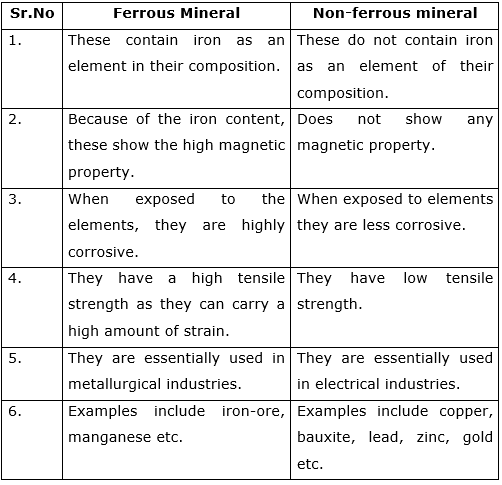
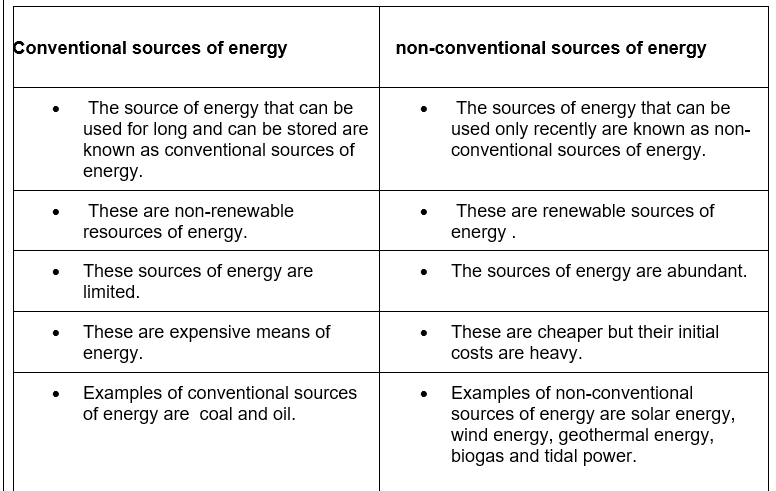
Q2. How are minerals formed in igneous and metamorphic rocks?
In igneous and metamorphic rocks, minerals may occur in cracks, crevices, faults, or joints.
The smaller occurrences are called veins and the larger are called lodes. They are also formed when minerals in liquid, molten and gaseous forms are forced upward through cavities towards the earth’s surface.
They cool and solidify as they rise. Major metallic minerals like tin, copper, zinc, lead, etc. are obtained from veins and lodes.
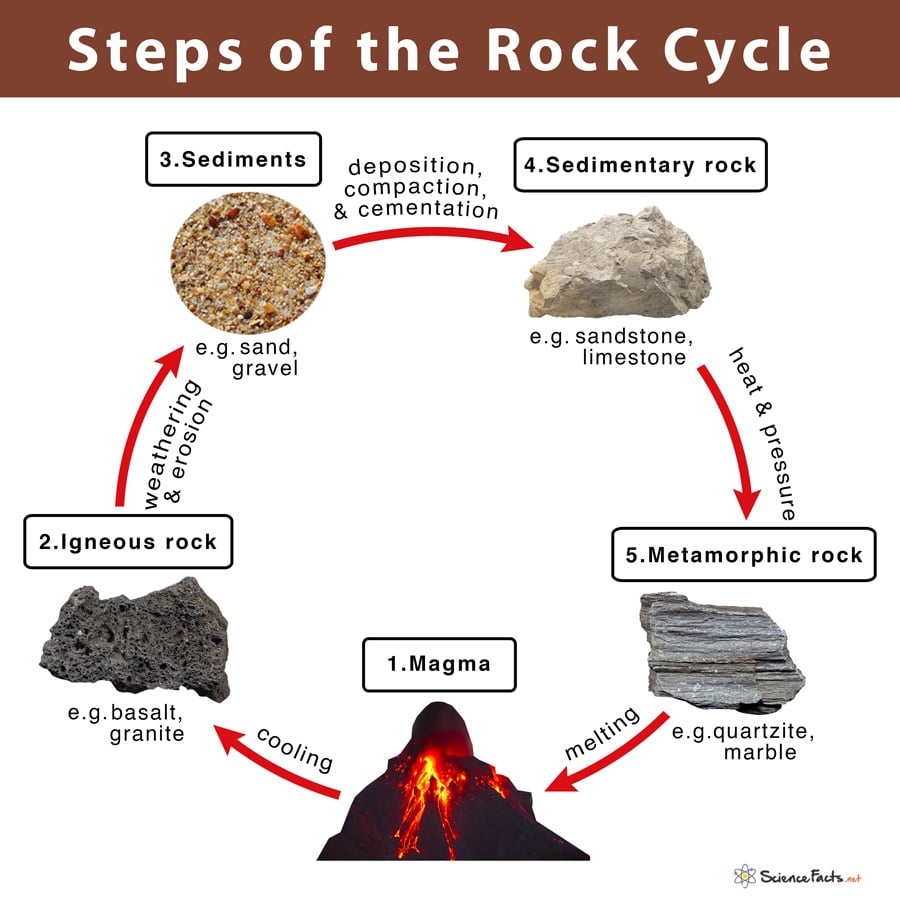
Q3. How do we need to conserve mineral resources?
Since energy is a basic requirement for economic development, we need to conserve it. To have sustainable development, we need to promote energy conservation by avoiding wastage and increasing the use of renewable energy sources.
So, we should conserve energy resources by using public transport systems instead of individual vehicles. switching off electrical appliances when not in use using power-saving devices using non-conventional sources of energy.
Q4. Describe the distribution of coal in India.
Occurrence of Coal in India:-
In India, coal occurs in rock series of the following two main geological
ages:-
Gondwana Coal:-
This coal was formed over 200 million years ago. This type of coal is used in
metallurgy. The major sources of Gondwana coal are located in the Damodar valley
(West Bengal-Jharkhand). In this belt, Jharia, Raniganj, and Bokaro are important coal fields. Coal deposits are also present in the Godavari, Mahanadi, Son, and Wardha valleys.
Tertiary Coal:-
This coal was formed 55 million years ago. This type of coal is found in the
North-Eastern states of Meghalaya, Assam, Arunachal Pradesh and
Nagaland.
Minerals And Energy Resources Class 10th: Map Work
This map shows the major coal mines and oil fields of India
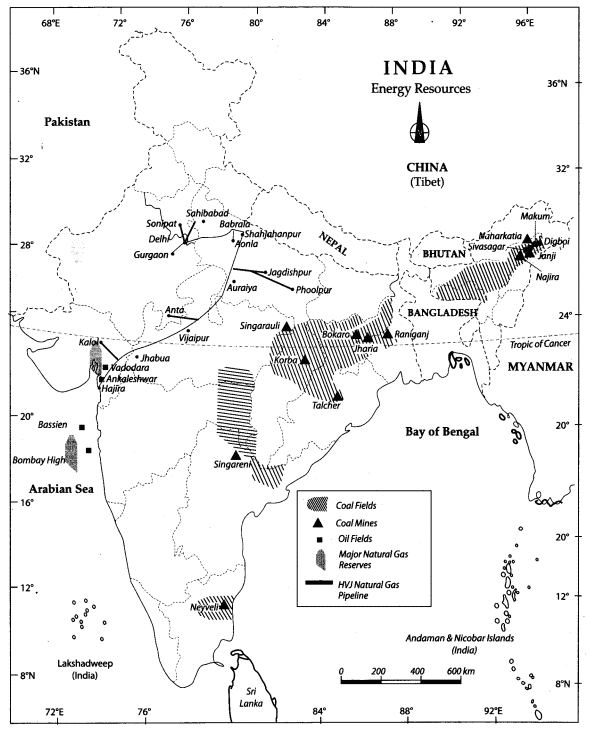
This map shows the nuclear and thermal power plants in India
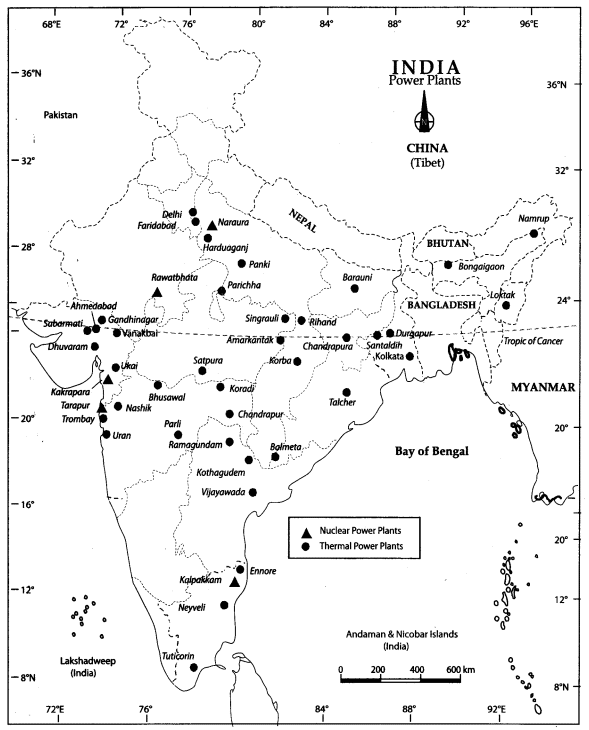
This map shows the distribution of iron ore, manganese, bauxite, and mica in India
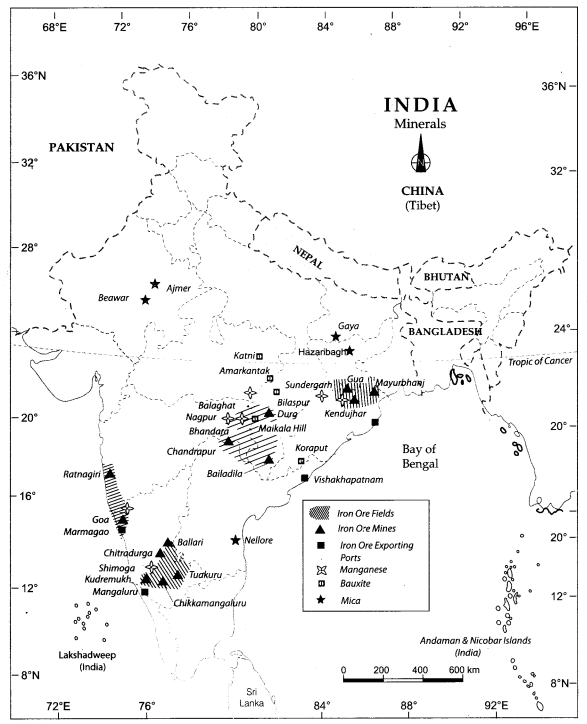
Question 1.
Locate and label the following items on the given map with appropriate symbols.
1. Raniganj
2. Bokaro
3. Kalol
4. Korba
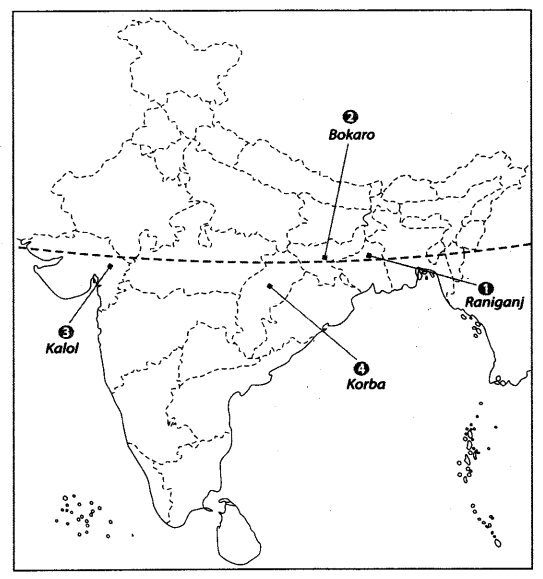
Question 2.
Features are marked by numbers in the given political map of India. Identify these features with the help of the following information and write their correct names on the lines marked on the map.
1. An Oil fields
2. A Coal Mines
3. An Oil fields
Question 3.
Locate and label the following items on the given map with appropriate symbols.
1. Naraura nuclear power plant
2. Kalpakkam nuclear power plant
3. Tarapur nuclear power plant [CBSE 2016]
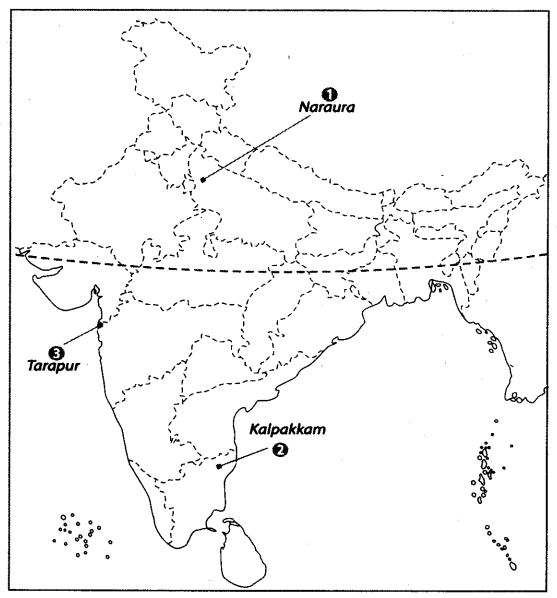
Question 4.
Features are marked by numbers in the given political map of India. Identify these features with the help of the following information and write their correct names on the lines marked on the map.
1. A thermal power plant
2. A nuclear power plant
3. A thermal power plant
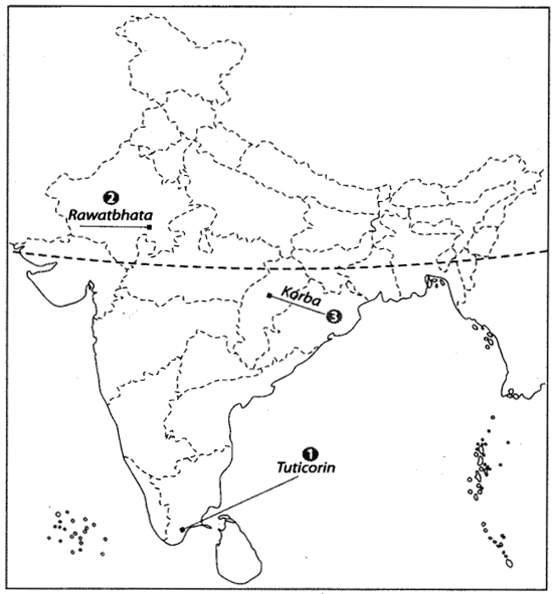
Question 5.
Locate and label the following items on the given map with appropriate symbols.
1. Kakrapar nuclear power plant
2. Vishakhapatnam iron ore exporting port
3. Belagavi silk industry
4. Bhilai iron and steel industry
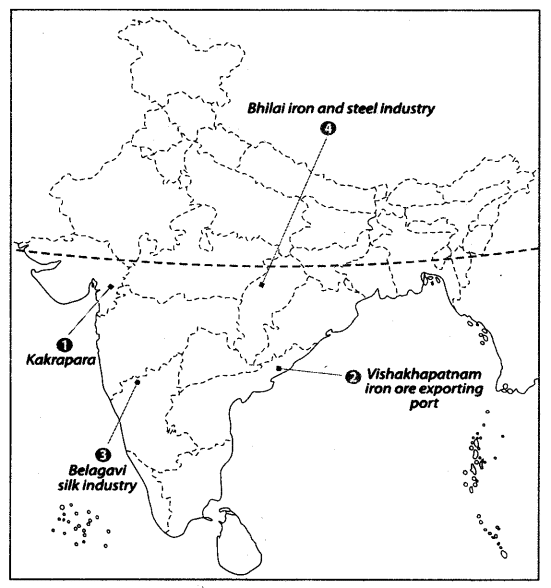
Conclusion
We provide you with Minerals And Energy Resources Class 10th notes to help you all to be thorough with the lesson Minerals And Energy Resources Class 10th mind map to glance at the lesson at once.
We have also provided you all with the NCERT Solutions For Class 10th Social Science Minerals And Energy Resources along with the map work and important diagrams to help the board-appearing candidates with the lesson and boost their class 10th preparation with that we have mentioned Minerals And Energy Resources Class 10th MCQs to help the students to get a thorough idea of the lesson and help to know the gist of the lesson.
Related Articles

